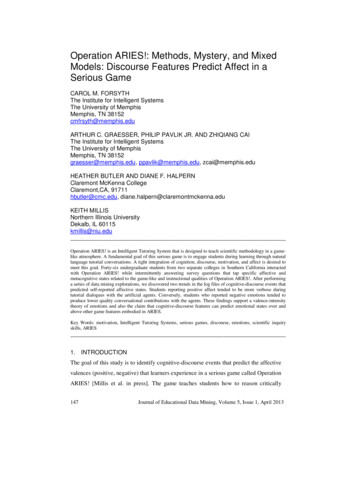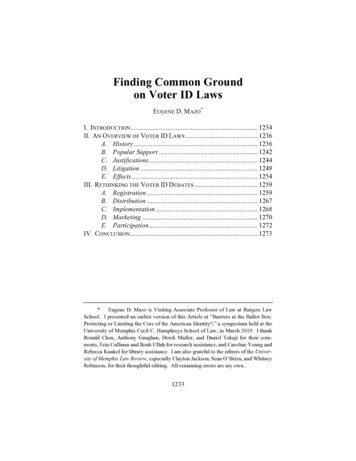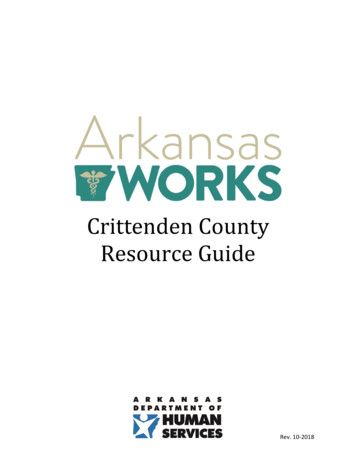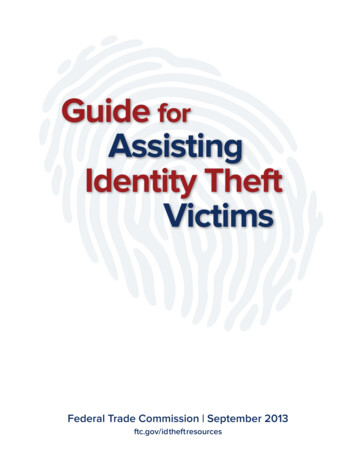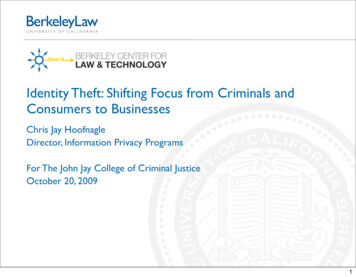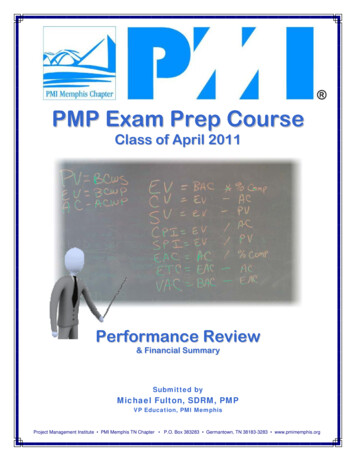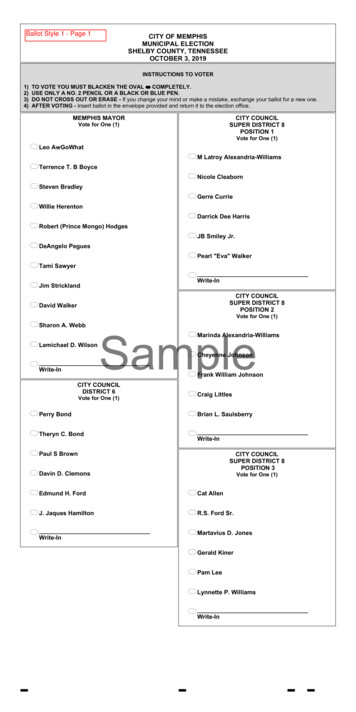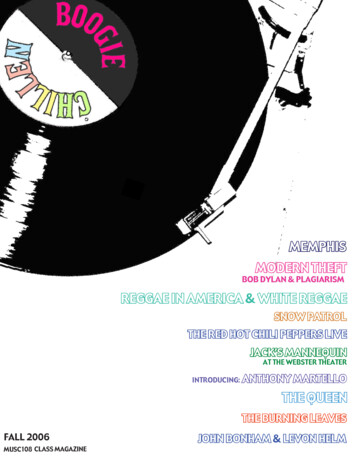
Transcription
MEMPHISMODERN THEFTBOB DYLAN & PLAGIARISMREGGAE IN AMERICA & WHITE REGGAESNOW PATROLTHE RED HOT CHILI PEPPERS LIVEJACK’S MANNEQUINAT THE WEBSTER THEATERINTRODUCING:ANTHONY MARTELLOTHE QUEENTHE BURNING LEAVESfall 2006MUSC 08 class magazineJOHN BONHAM & LEVON HELM
MEMPHISMODERN THEFTREGGAE IN AMERICA, THE UK & WHITE REGGAETHE RED HOT CHILI PEPPERS LIVETHE BURNING LEAVESJOHN BONHAM & LEVON HELMJACK’S MANNEQUINAT THE WEBSTER THEATERINTRODUCING:ANTHONY MARTELLOSNOW PATROLTHE QUEEN
4laura nahmias8logan needle13 megan willey & jamie wendel15 joan bosco17 alex kaufman20 dustin brockner23kaitlin halibozek26amy lum27molly adams29dan delalla
“Everything that has existed is eternal,the sea throws it back on the shore.”“That is why art alone, by being inconsequential, is capable of grasping it. It is impossible to give a clearaccount of the world, but art can teach us to reproduce it-just as the world reproduces itself in the courseof its eternal gyrations. The primordial sea indefatigably repeats the same words and casts up the sameastonished beings on the same seashore. But at least he who consents to his own return and to the returnof all things, who becomes an echo, and an exalted echo, participates in the divinity of this world.” (AlbertCamus, The Rebel)“People down here don’t let nobody tell them what to do.” –Dan Penn, on the SouthLaura NahmiasMemphis is this queer place where everyone is so involved in their own businessthat they can’t get any sense of historicity,that they can’t see their own place in theworld. It is a place of immense historicalimportance, but it seems to take for grantedits own generative power. Its heart is in theright place, but it doesn’t have any commonsense. All of the threads of soul music justform a part of the collective consciousnessin my memory, without a history. This isthe place where Isaac Hayes is just the manwho hosts the radio show “Hot ButteredLove Songs,” on 103.5 The New Soul Classics, where a member of the Mar-Keys runsa really excellent Italian deli , and WilliamEggleston can be seen on any given day ofthe week mowing his lawn. There is magicin these details and there isn’t anyone towrite them down until they’re gone. Memphis’s issues with historical preservationtake form in the fate of the Stax studio, thelifeblood of Memphis music, and what onewould consider a landmark for Americancultural history.“On the theater marquee would soon appearin giant letters of red plastic, Soulsville U.S.A.(for a while, in more socially conscious times,Stay In School). In later years the theater wouldbe pointed to as the cause: it was the configuration of the sloping floor, it was the giant,bass-heavy u-8 movie speakers that madeeverything sound that much better on theplayback. It was the retail record outlet, the satelliterecord shop, which occupied the former candy andpopcorn stand and served as a kind of on the spotbarometer of taste for the fledgling operators ofthe label . It was the neighborhood: local kids dropping in after school, future songwriter David Porterbagging groceries at the Jones Big Star across thestreet, Booker T . and William Bell attending thesame church nearby.” (97)(From Sweet Soul Music, on Stax Recording Studios atEast Mclemore Rd., Memphis)The theater, in true Memphian obliviousness,was torn down in the late 80’s, quietly, since noone could fight for it after its condemnation. Ithas since been rebuilt and christened the StaxMuseum of American Soul Music. If you visitthere today, which I recommend for the excellent memorabilia they have on display, including some documentary footage of the Stax/Volttour in Europe which is really sensational, youcan loo k across the way and see the stonefoundation of the Jones Big Star, a Memphischain which closed down about 10 or 15 yearsago if I remember, and from which the seminalMemphis rock band Big Star derived theirname.In August my friend Kate and her road trippartner Tonya stopped through Memphis ontheir way back up to Ohio, and I told them theycould stay at our house. Coincidentally a closegirl-friend of mine, Alex was returning from aforay to the west coast in order to meet up with
a mutual friend, Ben, who had taken a job atthe local paper, for the summer. When we metup, toward the middle of August, our guestsasked me what there was to do in Memphis.“Memphis in the mid to late 60s was like aboomtown in the middle of a religious awakening. The success of Stax, and the flood ofimagined possibilities which that success unleashed, set off a chain reaction that foundevery entrepreneur in town getting into the“record bidness.” Memphis, after all, is atown that has never been prone to self-doubt;civic pride has always held that a city whichgave birth to the Piggly Wiggly, the HolidayInn, Elvis Presley, and the blues, which couldboast of its reputation as one time murdercapital of the world, was somehow touchedwith magic. When that magic showed up allof a sudden in the realm of rhythm and blues,there was no one, it sometimes seemed, whowas not prepared to take the leap, no matterwhat might be his or her lack of previous experience.” In the summer, the weather in Memphis is sothick you feel like you can hold onto it, andwhen you’re young you have two options:you either sit around with the old people andsip on half and half teas while you complainin a spirit of brotherly agony, or you pretendlike it doesn’t really matter and relish thesweat. We have an air conditioner at myhouse though, so the answer to the query ofwhat to do was manifest. We would go outand sweat.Ben was the best dancer I had ever met; Icouldn’t for the life of me figure out why he hadchosen to take a job as a newspaperman, butit turned out that his job, at the local alternative weekly, included a fair amount of foraysinto the social world, and he could subsidizetrips to the Kentucky derby, Crunkfest 2006,(a crunk concert that erupted in some mildviolence) or the ring of local concert venuesand juke joints, thereby fulfilling the requirements of his job, while still getting a little
shakin’ in on the side. He thought it would be a goodidea to take our guests to a black dive bar.“And yet it was rapidly taking on a cast and acharacter all its own, unorthodox, even forMemphis, which has always been known forits unorthodox operations. Every morningEstelle’s son Packy Axton, would open upthe studio [Stax], prompted by a remindercall from his mother at the bank any nighthe wasn’t playing with the Royal Spades (thehigh school band which had rehearsed suchlong and enthusiastic hours out at the studio inBrunswick), he was club-hopping with someof the characters he had met at Satellite(therecord store,) soaking up the atmosphere atvarious r ‘n’ b joints around town, showingup, according to William Brown, in placeswhere few other whites would dare toventure.”(107)Wild Bill’s, is run by Wild Bill, and is located ina strip mall in North Memphis, a black neighborhood bordering the triangle of affluent white people that stretches east from itscenter in the area known as Hyne Park. This isnot to be confused with South Memphis , affectionately referred to as “Hell” and hometo illustrious rappers three six mafia andGangsta Blac. White people usually don’tstray into this neighborhood, and if they do,they get friendly warnings from gas stationattendants or restaurateurs to keep moving.(this happened ot me about six months ago)But Wild Bill’s, unassuming as it is nestled inthe low-lying, fluorescent lit strip mall, is adifferent situation, and the atmosphere issomewhat friendlier.“The other factor that contributed to magicin the air was that “transracial,” almostbebop atmosphere which ahs been variously ascribed to Packy, to Chips, and to theMcLemore location, and which would havebeen remarkable for anywhere in 1960, letalone Memphis and the south. Memphis in1960- and not just on the testimony of jerryWexler either-was a strictly segregated town.Despite the social revolution struggling to takeplace, despite Memphis’s reputation as thehome of the Blues, despite WDIA and the birthof rock ‘n’ roll at the Sun Studio at 706 Union,there were not a lot of places for black andwhite to mingle easily. White teenagers whowanted to be “daring” went over to the Plantation Inn in West Memphis (rhythm and blues thefare, clientele strictly white), where PhineasNewborn, Sr. Ben branch, and trumpet playerWillie Mitchell led jumping little bands ” (110)Wild Bill sits at the door, on a stool, lookinggrizzled, maybe like he has glaucoma, but he’swearing the best dark suit, and sweating profusely. If I can recall he had on a yellow tie thistime, and a black fedora, cocked so that thered lightbulb just inside the door highlighted the slick on his bald head. So we paid ourcover charge, and sat down inside. The wallsare painted red, and Christmas lights danglelimply and flicker in one place back near thefluorescent lighting of the kitchen. The wallsare covered with slightly outdated posters ofhalf naked women with L.A. Looks hairstyles,and photographs of patrons with Wild Bill,whose expression hardly varies from photo tophoto. Patrons laze in stiff back chairs againstchecker table cloth covered card tables.There’s a menu up on the washboard, and Alexand Kate ask me what chitlins are when theysee that it’s the Friday special. The only alcoholavailable is Budweiser in 40 oz bottles, whichalso seems to amuse our guests. It turns outquite fortuitously, that we are sitting next to theformer Trezevant High football coach, a figureof some local fame, if I can recall, for somecollege recruitment scandal, but he’s holdingonto a bottle of Stoli vodka and a little plasticcontainer of cranberry juice, and laughingfrom the bottom of his stomach. We got therejust as the show was starting. The main event isa group of musicians who call themselves theSoul Survivors, who’ve set up their instrumentsin the front left corner of the bar. At our cardtable, we have our right sides to the musicians,who invite their guest singer (new guests everynite!) up to the microphone. She is a beauti
ful, rotund woman named Miss Minnie, andI get the distinct feeling that she knows boththe football coach, and my dear friend Ben,from former interactions at this very locale.She starts to sing, something raunchy, whichhas all of the women in the bar laughing bellylaughs and all the men pointing and slapping.Basically there’s a lot of side to side motionsgoing on. One couple, elderly and elegant,are dancing, dirty-dancing on the dance floor.Miss Minnie wastes no time in congratulating them on, something, which also rousesno small amount of laughter. The Trezevantfootball coach, Coach Carr, offers me and ourentire party vodka and cranberry in tiny bathroom cups, with a conspiratorial but amiablelaugh, and we accept in good faith. We are theonly white people in the room, but it actuallydoes not seem to matter. I think maybe everyone is drunk already.“There are lots of reasons, of course, whyblues should attract a white audience of someproportions. There is, to begin with, a questionof colour. Most of us had never known a Negro.That didn’t stop us however, from constructinga whole elaborate mythology and modelingourselves in speech and dress and manneralong the lines of what we thought a Negrowould be. Norman mailer has expressed thisattraction well in “the White Negro.” It wasreally, the whole hipster pose. But it was also,as Eldridge Cleaver has pointed out, that rockn roll represented not only an implicit socialcommitment but the explicit embrace of ablack subculture which had never previouslyrisen to the surface, so that we were set up,really- was, anyway, along with my friendsfor the adoption of a purely black music and apurely black culture. Blues offered the perfectvehicle for our romanticism. What’s more, itoffered boundless opportunities for embroidery due to its exotic nature, the vaguenessof its associations, and certain characteristicsassociated with the music itself. For one thing itwas an undeniably personal music; whateverthe autobiographical truth of the words, eachsinger undoubtedly conveyed something of himself in his song.”(Feel like Going Home,22)Miss Minnie launches into another slow,growling song, half-familiar, and the otherwomen in the bar offer some rousing affirmations, “take what you want, but get what youneed.” She sings a Wilson Pickett song, “6345789,” and a Carla Thomas song, “Tramp,”and Ben gets up with a full body shiver, likesomeone just walked over his grave. Thisis how I know that he is going to dance. MissMinnie pointedly asks the crowd how theyfeel about shaking a tailfeather, can she seeus shake a tailfeather, wont we wont we, andthey call back. Ben and Alex and Kate startto quiver a little bit as Miss Minnie rolls backinto the band and disappears. The old menand women in the club are bent over, shakinga tailfeather, Tonya is slumped over in herchair clutching a forty and talking to a manwith several gold chains and a pale blue suit,and I’m fielding queries from the Trezevanthigh football coach, the replies to which aresummarily ignored. The band, the horns, thesax, the keyboard are sort of rocking fromside to side, in the same motion as the assesof approximately half the patrons, and theTrezevant high football coach hands me alittle baggie filled with pot, telling me to havea good time ; this phrase is cut off at the endas he turns a quarter turn away from meand introduces the Stoli and cranberry to awoman with cat-eye glasses on his right.I wasn’t about to look the gift horse in themouth, tucked the baggie into the lining of myjeans, and shook my tailfeather. Tina Turnerwould be proud. When Miss Minnie starts togrind up on Ben she starts talking about howthey always do the next song, rough, but theynever do it nice, and easy, and I know she’sgoing to sing Proud Mary. I start to roll a littlebit and Kate turns to me, and whisper-yells,“I’m having the best time.”
M odern T heftLoganNodding by the fire in divine solitude,Bob Dylan mulls over ideas for his inevitableupcoming release but he’s all used up, thefields have turned brown . Sad-eyed , vacantand numb , and with Boticcelli’s niece nowherein sight to be his muse, Dylan totters over tothe bookshelf, takes down the works of HenryTimrod, Poet Laureate of the Confederacy, andrifles through in search for a rhyme. There it is,the perfect line! Bob buries the book deep in hischest, hunching over like Quasimodo to shield itfrom view, a mad grin on his face. His prayershave been answered; he can once again wowthe world with his indefatigable wisdom they’llnever know!I can’t imagine that anyone actually thinks thisis how Bob Dylan wrote Modern Times, like ahigh school student cheating on a paper. Butsince 2001, accusers have been shouting theft,without much love. The “Folk Tradition” is noexcuse for these Googling finger-pointers.What has arisen in the last five years is a newway of looking at studying, attacking, downplaying, obsessing over, and, for most of us, enjoying Dylan. Surprising? He’s been called a lotof names before – Thief, Joker, Judas, God justto name a few – because he’s Bob Dylan, the ultimate trickster. He’s always been cagey aboutrevealing his influences - it’s bad for mystique and Bobby is all about mystique. He’s constantlyNeedletransforming himself, his music, and the waythat we, his alternately adoring or abhorringaudience, perceive it. So we have, at the veryleast, always had a lot to talk about, and thisnewest revelation - the lifting of lines fromthe poetry of Henry Timrod and using themin Modern Times - is another chapter in theever-evolving epic that is Robert Zimmerman. Do I concern myself much with thesecharges of plagiarism? Not really – whenit comes to Dylan, I’ve learned not to argueor to judge . But with everybody shouting “which side are you on!?” while calypsosingers laugh at T.S. Eliot . perhaps it is worthsome discussion. It was Eliot, after all, whofamously stated: “Immature poets imitate;mature poets steal.” Modern Theft.First thing’s first: what is plagiarism and whencan it be applied? Where there does seem tobe a general consensus is in the definition plagiarism is the act of taking someone else’swork and passing it off as one’s own, whereaswith allusion, the author does not wish toconceal their source. This applies, however,to academic works - theses, dissertations,and things of that nature. Here, we’re talkingabout songs. Where was all the fuss when“A Hard Rain’s A-Gonna Fall” came out?One might argue that “Hard Rain” is the folktradition in its purest form, borrowing fromScotch-Irish ballads to create an ominous
and timeless atmosphere, blending the medieval with the modern. But that is exactlywhat Dylan does on Modern Times, and whathe’s always done. “I think that’s the wayBob Dylan has always written songs,” saidScott Warmuth, the New Mexican disc jockeywhose Google philandering uncovered thelifted lines on Modern Times. “It’s part of thefolk process, even if you look from his firstalbum until now.” Love and Theft, his lasttitle before Modern Times, seemed a quiteobvious reference to its own allusions, butthe problem for some has been that ModernTimes does not explicitly credit Henry Timrod(just Charlie Chaplin?). Dr. Stephen Scoobieof the University of Alberta spoke in defenseof Dylan’s use of English Nursery Rhymes,African-American Blues, and an obscure1950s pop song to pen the lyrics of Love andTheft, explaining that, “Dylan takes the wholeidea of love and theft very seriously. He lovesthe stuff, but also unashamedly steals it. Youcould call it post-modern intertextuality, orgood old-fashioned plagiarism.”I, for one, would call it neither. but this isgetting interesting! Intertextuality? Dylan thepost-modernist? Again, why didn’t anyonecry “intertextuality!” way back when “HardRain” came out?it for a long time; and as this funny old worldkeeps a-comin’ along , he may be sure thatreams of doctoral theses, tomes weighty,tomes flighty, by the highly-cultured and thelowly-obsessive, and of course, an Amazonof blogs, will silt the mind ‘til the levees of unconsciousness break. but time must have astop.Bob knows the extent to which his everyword is scrutinized - he’s been dealing withThe latest installment in Dylan’s Renaissancetrilogy, Modern Times is as steeped in blues Indeed, Aldous Huxley borrowed the titleTime Must Have a Stop from Shakespeare’sHenry IV (Part I), Hotspur’s final words beforebeing skewered by Hal. Shakespeare himselfwas prone to borrowing, lifting plotlines fromvarious other sources. The plot of As You LikeIt was taken almost directly from ThomasLodge’s Rosalynde, but I doubt Shakespearean scholars would call that intertextuality. Itis worth noting that Dylan’s influences are sodiffuse as to make his ability to incorporateall that he has heard and read all the moreunbelievable and rewarding for listeners.“Chekhov is my favorite writer,” he told RonRosenbaum in a 1978 interview, and in theliner notes for Biography, Dylan advises, “tothe aspiring songwriter and singer I say disregard all the current stuff, forget it, you’rebetter off, read John Keats, Melville, listen toRobert Johnson and Woody Guthrie.” .
and folk influences as were the previous twoparts, 1997’s Time Out of Mind and 2001’s Loveand Theft. With each passing year, Dylan’s voicesounds more experienced and otherworldly.Here, his blues pour down like rain:Gonna raise me an army, some tough sons of bitchesI’ll recruit my army from the orphanagesI been to St. Herman’s church; said my religious vowsI’ve sucked the milk out of a thousand cowsI got the pork chops, she got the pieShe ain’t no angel and neither am II did all I could, I did it right there and thenI’ve already confessed - no need to confess againThus Dylan and his band furiously launch thealbum with “Thunder on the Mountain.” Thedrums shuffle with brushes, the piano is pumpinglike Jerry Lee Lewis, the bass is popping, and theslide guitar sounds like it’s channeling MichaelBloomfield a la Highway 61 Revisited. But theseare not just blues songs. “Spirit on the Water” isa celebratory, beautiful parlor song with slippery jazz chords. “When the Deal Goes Down” isadmittedly taken from Bing Crosby’s trademarksong “Where the Blue of the Night (Meets the Goldof the Day)” but no one’s going to mistake Bobbyfor Bing. Actually, Dylan’s singing style in thesesongs comes not from the mean-hearted crooning Crosby, but from the great blues and jazzmanLonnie Johnson, whose version of “TomorrowNight” Dylan has been playing in live sets foryears. In Chronicles, the first volume of his spectacularly entertaining and eloquent autobiography, Dylan discusses the influence of LonnieJohnson on his songwriting, which is clear in thesweet song ambition of “Spirit on the Water.”With “Rollin’ and Tumblin’” Dylan swipes theriff, title, and tune itself from Muddy Waters’version of Hambone Willie Newbern’s “Rolland Tumble Blues.” On “Someday Baby”Dylan evokes Sleepy John Estes’ “WorriedLife Blues” (aka “Someday Baby” or “TroubleNo More”) which has been covered beforeby Dylan at Toad’s Place in 1990, as well asby Fred McDowell, Lightnin’ Hopkins, MuddyWaters, Chuck Berry, Eric Clapton, and theAnimals, among others.Coming out on the anniversary of Hurricane Katrina, “The Levee’s Gonna Break” isa poignant condemnation of the greedy andpowerful, while “Workingman’s Blues #2”mourns the fact that “the buyin’ power of theproletariat’s gone down/Money’s gettingshallow and weak. they say low wagesare reality if we want to compete abroad.”These songs walk the line between thetopical ballads of Cisco Houston and WoodyGuthrie and the love songs of Stephen Fosterand Leadbelly. The struggle in Dylan’s voiceshows that he doesn’t give into either side,but walks his own long and lonesome road,and where he’s bound, even he can’t tell. Along the way, though, he seems to haveseen it all and found it wanting. On ModernTimes, he comes in from the wilderness, setsdown his crown of thorns , and tells us thestory. And we’re lucky to hear it. Dylan is theroad-worn holy thief, the brawling but tenderhearted lover, the poetic pickpocket. Heknows his characters because he has beenall of them and can turn them all inside outin song. Modern Times explores a full range10
of emotion and experience, from love(“When the Deal Goes Down,” “Beyond theHorizon”) to mortality (“The Levee’s GonnaBreak,” “Ain’t Talkin”) to the state of theworld (“Workingman’s Blues #2”).The final track, “Ain’t Talkin,” reveals awandering pilgrim singing a gypsy balladto a lonesome fiddle, piano, and hand percussion. It is both ironic and fitting, with thegentle interplay of the instruments underscoring the seriousness of the words. Onething is made certain: he’s going to keep onkeeping on.In these ten songs, Dylan presents a newweird America with wild humor, bawdyjoy, bottomless sadness, and restlessheartache. With the aid of those who camebefore him, he creates an album that is bothmodern and timeless. Electric blues, porchand parlor tunes, and pop ballads thatcould easily have come out of the 1930scome together to produce a final productthat transcends its own origins. Everysong that has influenced him, Dylan contains within himself, and through his use ofthem, adds to their histories and legends. Ifa crime there be, all I can say is that geniusforgives more than we can fathom. That isfact, not elitist fancy. Should we think ourwonder boy - now our wonder-AARPcardholder - a saint? Of course not. If youwant a friend, get a dog. But ought we to bethe ones who put him out to death ? It ain’tme, babe .11*DISCLAIMER: Many of the lines in the abovearticle were shamelessly lifted from, primarily, Dylan’s own work. To avoid anylegal action taken against the author, thesources from which the lines were borrowedare listed below.W.B. Yeats “When You Are Old”Dylan, “Cold Irons Bound”“Sad-Eyed Lady of the Lowlands”“Not Dark Yet”“When I Paint My Masterpiece”“Love Minus Zero/No Limit”“Desolation Row”“Song to Woody”“Ballad of a Thin Man”“Don’t Think Twice, It’s All Right”“Shelter From the Storm”“Tangled Up In Blue”“I Dreamed I Saw St. Augustine”“It Ain’t Me Babe”
rt 1MEGAN WILLEYThe most idolized symbols of early Reggae areJamaican Rastafarians, characterized by longdreadlocks, a marijuana haze and red, green andyellow clothing, advocating rebellion and protest. Reggae is often referred to as “The Music ofParticipation,” because of its simple, danceablerhythms, positive messages and reproducibility. And although Reggae’s musical influence onmany rising Rock stars of the 1970’s and today’sculture is apparent, the general themes of Reggae are somewhat lost.Reggae is the modern popular music of Jamaica.The origins of Reggae stem from a direct lineagewith the Jamaican music culture, growing frommany different forms of Jamaican music including Mento (Jamaican folk music), Ska (also calledBluebeat), and Rock Steady. Specifically, the format of Reggae refers to heavy accentuation onthe second and fourth beat of a four beat bar. Thisformat originated in 1968, sparking a universal cultural trend that has continued, not only intoday’s Jamaican pop music, but the worldover. Other forms of Reggae include Dub/Roots, Dancehall, Ragga, Lovers Rock, and,the popular and apparent form in today’smusic culture; White Reggae (Reggae performed by mostly white musicians, generallytargeted to a white audience).Reggae is rebellious music, uniting the poorand oppressed while encouraging protestand revolt. It is also known as the voice of theRastafarian movement. Rastafarianism is anindividualized religion in which knowing Jah(God) is actually being him. In short, the general theme of Rastafarianism is that of repatriation to Zion (Africa); seeking a better lifewith a return to the homeland while rejecting white European culture. The Rastafarian movement had a great influence on thepoor and unemployed, localized mainly inKingston. The young Bob Marley exemplifiesthe movement’s most famous disciple. Mar12
Part 2Jaime Wendelley became the greatest advocate for themovement and the most prominent leaderof the tradition with his music. The themes ofthe Rastafarian movement also coincidedwith general feelings of oppression stemming from Jamaica’s colonial government,the United Kingdom. Thus Reggae music isa product of this counterculture of the poorblack community.In the 1950s, Ska (an energetic Jamaicanmusic style deeply influenced by blackAmerican musicians such as Fats Dominoand Louis Jordan) became hugely popularin the U.K.; resulting in United States recordcompanies attempted marketing of Jamaican music to international audiences.This initial attempt at marketing largelyfailed on the global scale. This did not reduce, however, its appeal to British youth.Although Jamaica won independence in1962, a close tie remained with the U.K.in the music world of youth culture. Thisculture embraced the music’s objectionsto general authority, and therefore, appropriated it as a representation of identityfor working class white youth. This subculture seeks a means to rise above theirsituation and express themselves in manyforms, music being one of them. Reggae,although initially representing discontentwith Jamaican society, also took on a universal identity for youth and its oppositionto society, better enabling British subculture to relate to Reggae subculture. Thismeans of identifiably for the British youthallowed for a large following of Reggaeamongst them.13Reggae music remained a part of the subculture in the United Kingdom and even theUnited States until the early 1970s. Beforethen, some Jamaican reggae artists, such asMillie Small, Desmond Dekker, and JimmyCliff, as well as American artist Johnny Nash,experienced marginal international success.The mainstream audiences did not embracethe rhythms and melodies of reggae music asrock music was in popular demand.It was not until Chris Blackwell, the president of Island Records, and Bob Marley &the Wailers released their first album, Catcha Fire (The Bob Marley Story), that reggaemusic truly exploded onto the internationalscene. Blackwell launched the Catch a Firealbum with the commercial appeal of a rockalbum; he cast the Wailers as rock stars, created a user friendly album cover completewith written lyrics for white audiences, andtoured through the United States and theUnited Kingdom, making radio and televisionappearances. Many other Jamaican reggaeartists followed this formula, such as Tootsand Maytals, Peter Tosh, Burning Spear, andBunny Wailer.While the records were marketed differently,other aspects of authenticity in the Jamaicanreggae aesthetic were also questioned inthe new international scene. The reggae ofthe 1970s continued to address issues of Jamaican politics: the oppression of the poor,repatriation, the fight against authority, andRastafarian ideology; but was often lyrically altered to have more universal appeal,based on the universal theme of protest.
Qualitatively, international reggae had a muchmore polished, studio appeal than earlier reggaemusic. Many early tracks were edited, mastered,and over-dubbed in studios in the United Statesand the United Kingdom. The instrumentation ofinternational reggae was also altered; many producers de-emphasized the electric bass guitarand drums to create a softer reggae sound, borrowing from some American genres. The changes in sound and instrumentation in internationalreggae music brought about some controversyamong reggae purists.The commercial appeal of international reggaeattracted the attention of not only white audiences, but also white musicians. As early as the early1970s, white artists from the United States and theUnited Kingdom began borrowing elements ofthe reggae aesthetic and implementing them intotheir music. Paul Simon was the first to do so in1972 with the song “Mother and Child Reunion
Feb 06, 2008 · THE RED HOT CHILI PEPPERS LIVE INTRODUCING: ANTHONY MARTELLO REGGAE IN AMERICA & WHITE REGGAE THE QUEEN MODERN THEFT BOB DYLAN & PLAGIARISM MEMPHIS MUSC 08 FALL 2006 . in my memory, without a history. This is the place where Isaac Hayes is just the man who hosts the
